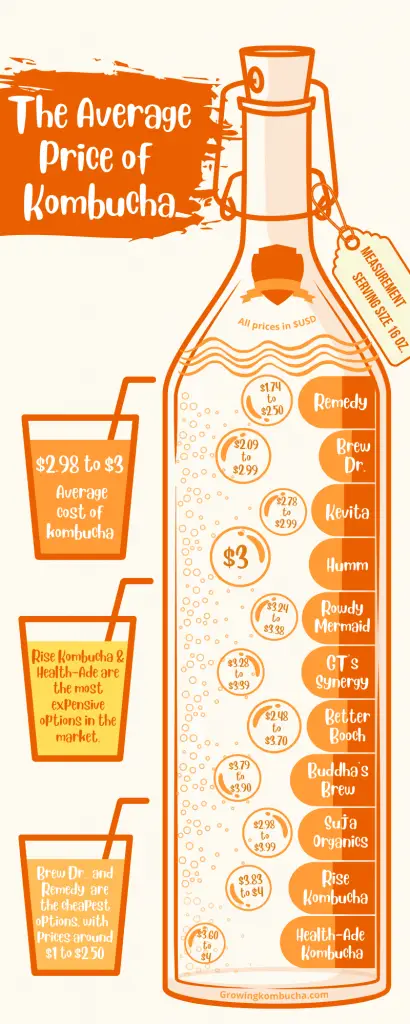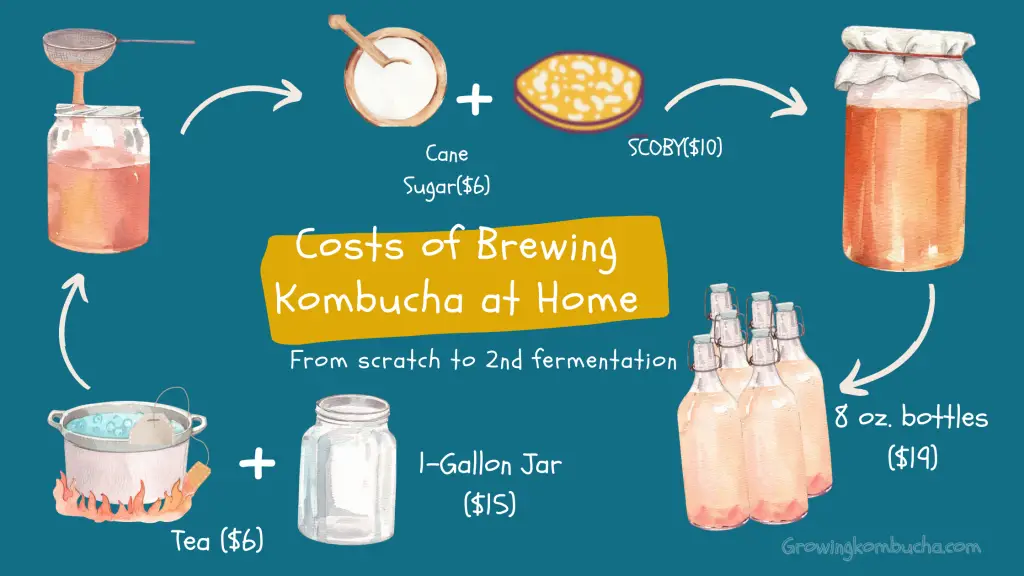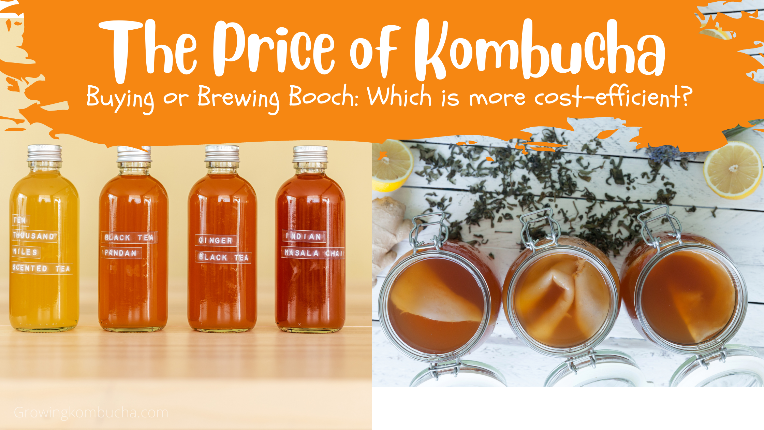Kombucha is not your average drink in both its taste and price. The price of kombucha ranges from $3 to $6, depending on the brand and the flavor. It is three times the price of a can of soda. In this post, discover if you’re better off brewing your own and the reason why store-bought kombucha is so expensive.
Despite the hefty retail price, many converted kombucha drinkers patronize commercial brands because of several benefits like convenience, safety, and flavor selection. One angle that can drive the price of kombucha in the market is its category of being a health drink. However, there’s more than what meets the eye.
Why kombucha is so expensive
The price of kombucha is driven by the nature of making it, who manufactures it, and market standards for health drinks. To discuss this in detail, here are the driving factors that increase the cost of commercially-available kombucha:
- Handling and storage costs: The nature of kombucha fermentation takes several weeks. Since it is a product in the middle of the fermentation process, kombucha is sensitive to temperature.
From brewing, bottling to store distribution, the temperature should be around 75 ℉ to 80 ℉ to keep the kombucha from continuing its fermentation. When kombucha continues to ferment, its taste becomes more acidic, altering its taste into vinegar.
Temperature control and storage for kombucha products can be costly since they will be running 24/7 to maintain the quality of kombucha.
- Flavor & ingredients: Another factor that makes kombucha more expensive than others are the flavor selection and filtration process of every brand. There are single-flavored varieties and specialty mixes that produce unique flavors from unexpected pairs like grapes and basil.
Every brand also adds some unique features to their product like the lower alcohol content. Brew Dr. uses special equipment where they minimize the ethanol in kombucha from 0.5% to 0.1%. They do this to make their product available for all ages.
GT’s Synergy Kombucha line invests all its efforts in creating new flavors. Today, they produce 40 kombucha flavors and the best-selling variants include GT’s Synergy Trilogy and Synergy Gingerade.
- Branding and labor costs: Kombucha brands are competing not only for the taste of their products but also for the image of their brand. Brands like Suja Kombucha take an intricate approach to their packaging, from its design to its matte-finish labels.
Logistics is also one of the main drivers of cost. When brands enter the big box retailers, they will require more manpower to sustain the demand.
- Beverage category: Kombucha belongs to the health drink category, which you notice is a few dollars more expensive than your typical fruit juice. The cost comparison between unhealthy and organic foods has been a subject of concern for several years in the commercial food supply.
The problem with the food and beverage supply chain is it struggles to meet the market demand due to production challenges. These challenges involve farming practices and natural methods that add up to the overhead costs, leading to an increase in price.
Processed drinks like soda cost less than healthy and organic drinks because they are easier and more manageable to produce. Considering that the materials in brewing kombucha are cheap, the average retail price will still be stretched out by other factors like market value, storage, and market-value costs.
Comparing the price of kombucha: Homemade vs. store-bought
If you’re a heavy-drinker, jumping from buying to brewing kombucha may look like a more practical route. It’s the same concept as brewing your coffee versus buying a fancy cup in Starbucks. However, there are pros and cons to both options. Here are some perspectives on both options to help you decide:
Looking through the average price of kombucha in the market
Many kombucha manufacturers at the beginning of their business have struggled to make a profit. Health-Ade co-founder Daina Trout mentioned that they were $10-worth kombucha and sold them for $5.
The good thing is their Health-Ade kombucha flavors were selling like hotcakes. They are now sitting next to Kevita and GT’s Synergy for being the top kombucha brands in the market. However, their price point remains at the premium tier with costs ranging from $3.60 to $4 per 16 oz. bottle.
As most kombucha suppliers improve the efficiency of their processes and acquire more equipment, the overhead costs decrease. However, as the demand for the product increases, most businesses also see an opportunity to offer it at a higher price.

To check the most expensive and most affordable kombucha in the market, we evaluated 12 kombucha brands available in big-box retailers. Here are some noteworthy insights we’ve found:
- The average price of kombucha in the market is $2.98 to $3.
- 2 out of 12 brands which include Rise Kombucha, a Canadian-owned brand, and Health-Ade sit at the top for being the most expensive kombucha in the market.
- Health-Ade is the leading kombucha brand for the best-tasting kombucha flavors. Most kombucha drinkers see the value for their money in Health-Ade, regardless of how much a bottle can cost.
- Kevita And GT’s Kombucha belong to the top 3 kombucha brands but they keep their prices within the average rate.
- The most affordable kombucha brands are Remedy and Brew Dr. Kombucha. They both have unique features to them where Remedy has a long shelf-life among all brands. Brew Dr., on the other hand, ensures that their booches have no alcohol so kids can also enjoy them.
Pros and cons of store-bought kombucha
Kombucha brands were once home-brewers that entered the commercial market by overcoming common problems such as precise fermentation time and sterilization. Several benefits of buying commercial kombucha include:
- Convenience: You can drink as much booch as you want without worrying about how you’ll produce another batch.
- Time-efficient: You no longer have to wait for several weeks to have a sparkling glass of booch. There’s also no need for you to check on your brew from time to time.
- Flavor selection: You never have to go through the dreaded trial-and-error of finding the best mix of flavors for your booch. You just simply select a flavor online or in the market and you’re got to go.
- Few to no risk of contamination: One of the reasons why some people prefer buying kombucha is the risk of contamination in homebrews. Any microscopic spore or wrong fermentation practice can make you sick.
While there are a lot of benefits for store-bought kombucha, there are also some disadvantages, which include:
- Accumulated costs: Let’s say you’re drinking a $3 bottle of kombucha a day, multiply it with 365 days and you’ll realize you’re spending $1000 for a booch. Imagine if you save that amount or use it for other important stuff that you need, you’ll definitely ease off some financial stress.
- Changes in flavor: Due to changes in temperature in transportation and storage, the taste of kombucha might change before it even hits the shelves of supermarkets. Some become so sour that it overpowers the overall flavor of kombucha.
Most kombucha drinkers who converted into homebrewers are keen on achieving the specific taste that they want from their brew. If you want to have the freedom in exploring the taste that you like, you’re better off brewing your own. - Availability: There are some instances when your favorite flavor may not be available in your local store. Having a brew at home will give you the liberty to have your favorite drink anytime you want.
Costs of brewing kombucha at home
Watching so many people brew their own booch may encourage you to do the same. If you are drinking kombucha every day and know exactly the flavor that you want, you will surely save a lot of money with homebrewing. However, there are also some risks involved, such as contamination.
Before diving into the pros and cons of brewing, let’s discuss the costs of doing it at home. If you’re a beginner, you’ll need to invest in a jar, bottles, and a SCOBY to start brewing. These are all part of the initial cost.
The ingredients like tea, filtered water, and sugar are part of the production costs. If you live in a cold region, you may also need a heating pad to maintain the perfect brewing temperature for your kombucha. Here is a sample computation on the overall costs of homebrewing for beginners:

In adding both the initial costs and production costs from the sample in the image above you’ll be spending about $56. In 1 gallon of kombucha, you can produce about 6 to 7 8 oz. bottles for the second fermentation.
| Materials | Cost |
| 20 pieces black or green tea | $6 |
| 1-gallon jar with a cloth and rubber band | $15 |
| Organic cane sugar | $6 |
| Live SCOBY | $10 |
| 8 pieces 8 oz. swing top bottles | $19 |
| Total | $56 |
For the initial brew, each bottle will cost $8 to $9. However, you’ll only need to buy sugar and tea with the proceeding brews which will cost around $12. With that, each bottle will only cost around $1.71 to $2. It can even be less if you’ll get cheaper tea and sugar by buying them in bulk.
Pros and cons of homebrewing kombucha
Aside from saving hundreds of dollars, brewing your kombucha at home seems like doing a science project. Learning about the tips and tricks in fermentation will also help you gain more knowledge about mycology. More than that, here are the benefits of brewing kombucha in DIY style:
- Cost-efficient: The investment for your fermentation tools will pay forward when you start brewing several batches of kombucha. You’ll enjoy a $1 to $2 slash off on every 8 oz. booch. In one year, your $2 savings on every bottle will amount to $730. Now, that’s the perk of being frugal!
- Freedom to experiment: Once you learn how to adjust the taste of kombucha through fermentation, your creativity will be your limit. You can mix and match any herb and fruit that you want to produce something more delectable.
- Additional skill: Knowledge in fermentation is a life skill that you can bring anywhere you go. It will also help you ferment other foods and become a master of food preservation.
- Sustainable: Every brew will produce a SCOBY that you can use for your future brews. Kombucha is indeed a fountain of good stuff that keeps on giving!
Brewing kombucha at home is a fun activity until you experience contaminated and awful-tasting brews. To give you a glimpse of what’s ahead of you in homebrewing kombucha, here are some disadvantages that you have to consider:
- Contamination risks: Homebrewed kombucha have the highest risk for contamination because of the sneaky contaminants in the air or in the materials you use. Kombucha fermentation needs a sterile environment to ensure the safety of your brew.
- Unpasteurized brew: For some vulnerable groups like seniors and children, unpasteurized kombucha can be too risky to drink. Some kombucha brands in the market pasteurize their brew to kill all the bacteria, regardless if they are good or bad. They ensure that there will be no pathogens in their brews.
- Fermentation duration: There’s a different kind of thrill to wait for your kombucha to become tasty and fizzy. However, not all people have the patience to wait for the batch to fully ferment, especially if they are heavy kombucha drinkers.
- Mould problems: Ideally, the abundance of acids will control the contaminants in kombucha and keep it safe to drink. When the room temperature falls below the ideal kombucha brewing temperature, the production of acids becomes slower, leading to mold growth. Mould is a common problem that you should expect and be aware of when brewing your own booch.
The verdict: store-bought kombucha vs. homebrew
Now that you have an idea of the costs of both store-bought kombucha and homebrewing, it’s about time to assess your consumption and bandwidth. Here are some questions that will help you picture if you are fit to brew kombucha at home or not:
- Do you drink kombucha frequently?
- Do you have time to prepare your brew?
- Are you patient enough to wait for each batch to finish fermentation?
- Are you looking for ways to save more money?
- Can you handle unpasteurized kombucha?
You know you’re ready to be a kombucha homebrewer if all of your answers to the questions above are yes. In your homebrewing journey, always remember that there are potential health risks involved. The key is sterilization and you’ll become one of the hundreds of kombucha brewers around the globe sipping the fruits of their labor and patience.
Frequently Asked Questions (FAQs)
Is kombucha worth the money?
Kombucha is worth its price when it comes to its benefits on digestion and its ability to keep you away from unhealthy drinks. It also becomes a cheaper healthy drink if you brew your batch at home.
How much does a kombucha SCOBY cost?
The average cost of live SCOBY in the market ranges from $7 to $15. You may also check some options in local health food stores for cheaper options.
Is kombucha cheap to make?
Yes. Though you need an initial fund for the fermentation materials, you’ll likely spend around $12 or less for every batch. It will slash off $1 to $2 in every 8 oz. bottle from your usual kombucha spending.
